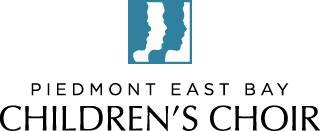2020 FALL NEWLETTER - The Virtual Season and Beyond
ZOOMING FORWARD!
As we have all settled into using Zoom as our primary medium of instruction, we’ve crafted a new curriculum that takes advantage of the opportunities and idiosyncrasies of the now-ubiquitous platform. We have found that individual voice lessons and small group instruction are the best ways to keep our choristers engaged online, and a generous anonymous donation has allowed us to hire a wonderful team of vocal pedagogues and elective instructors. Our Training Department students in GT2 and above enjoy voice lessons every other week, which facilitates greater musical growth and engagement. Meanwhile, our Performing Department students are exploring their creativity in their electives: crafting their own songs under the guidance of master singer/songwriters, exploring South Indian ragas or Beijing opera in musicology, and improving their sight-reading skills in musicianship.
Our singers have managed to carve out spaces in their homes to continue their musical training. They are singing, talking, laughing, and learning. Our instructors are excited by their continued enthusiasm for the choir, and grateful to the families whose support makes their continuing engagement with choir possible. By strengthening every individual voice, the choirs will come together stronger than ever before. We are all discovering our voices!
BEHIND THE SCENES AT A VIRTUAL CONCERT
Do you ever wonder what goes into the making of a virtual concert, such as our 2020 Virtual Spring Sing? Behind the 250 singers, each in their own square on the screen, are countless hours of video editing and the can-do spirit of the PEBCC technical production team! Production and Events Administrator Tate Bissinger and Artistic Director Eric Tuan spent many hours last spring learning the ins and outs of Garage Band, Adobe Premiere Pro, and iMovie under the thoughtful mentoring of Ecco’s Associate Conductor Joel Chapman. The tech team is now looking forward to exploring their creativity further as we produce new concerts for the 2020-2021 season.
The first step is to produce backing tracks to facilitate the recording process. Conductors, accompanists, and TAs all collaborated to record clear versions of each piece that the singers can record over. The most critical element is a countdown and a set of claps at the beginning of each backing track for the singers, which allows the production team to align the audio and video tracks when they bring them all together.
The next step, of course, is the most exciting - the recording! We’re so grateful to all the PEBCC families who propped cameras on bookshelves, got singers dressed in uniforms, downloaded backing tracks, and helped singers record themselves for the performance. Once all the tracks are in, Tate and Eric spent many hours aligning and editing all the vocal tracks, lining up hundreds of videos, and then arranging them artistically across the screen.
The final - and most anxiety-producing! - part of the process is uploading the final concert onto YouTube Premiere. These massive files, constructed from hundreds of individual videos, can take hours, even days, to export and upload! Tate Bissinger shares:
“Waiting for the upload bar to finally finish while watching the clock was very stressful. Sometimes I would have to go to bed and hope that it was finished without the upload being stopped for some technical reason. That is a nail-biting experience!”
Our upcoming concerts this season will take on a new look. Now that our production team is past the learning curve, they are looking forward to enlisting the singers’ creativity in creating artistically compelling and innovative digital performances. The first performances of the year will be premiered at the Benefit Concert and Auction. Purchase a ticket to support the choir and come join the fun!
TECHNOLOGY MOVING FORWARD
Choral organizations throughout the country are continuing to explore new ways to continue their singing during the pandemic. PEBCC has been keeping a close eye on the different emerging technologies and evaluating feasibility for use by our program. We are particularly grateful for Ecco’s Associate Conductor Joel Chapman, who continues to be involved in the development and use of low-latency platforms, for sharing his expertise with us.
The challenge of making music together online is latency: the time delay inherent in Internet transmissions. Several technology platforms that minimize latency (“low-latency platforms”) are available and are being used by some of our peer organizations, with the Virtual Studio program used by the Peninsula-based boys’ chorus Ragazzi having received the most attention.
While these platforms do allow for an online experience similar to a live rehearsal - singers can hear each other and the conductor - there are many challenges to implementing them. Colleagues who use low-latency platforms have shared that a considerable amount of technical support and knowledge is needed to download and use the software; it is not accessible to students on certain devices; the cost is substantial. We are currently trying to evaluate the advantages and challenges of these types of platforms, the main criteria being ease of use and accessibility for our community. You can help us discern if these platforms could be a good fit for us by filling out the TD Fall Rehearsal Survey or PD Fall Rehearsal Survey. In the meantime, we are also exploring platforms that may make it easier for singers to record backing tracks, hear themselves together as an ensemble, and hear progress in the group over time. We are particularly grateful to Steven Hendee, parent of Choral Scholar Kimiye Hendee, for sharing his expertise on SoundTrap with us.
If you have expertise in this area, please do let us know - we appreciate any and all connections. You can contact us by filling out our Connections Survey here.
Make sure to stay tuned!

